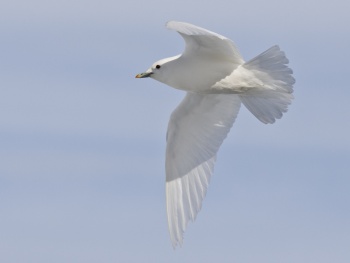- Pagophila eburnea
Identification
Length 44-48 cm (17¼-19 in), wingspan 106-118 cm, weight 520-700 g
A medium-sized gull
Adult
- Completely white plumage
- Thick pale blue-green bill with yellowish tip
- Dark eye
- Black legs
Immature
Takes 1-2 years to reach maturity
- Dusky face
- Variable amounts of black flecking in wings and tail; some heavily spotted black, others only lightly so
- Second year as adult, except occasionally with small black flecks on median and primary coverts and alula
Confusion species
Adult winter Mediterranean Gull can look almost as white from below in bright light, but has dark red bill and legs, and pale grey mantle obvious from above. Iceland Gull and Glaucous Gull are both substantially larger.
Distribution

Photo © by bobsofpa
Cape May, New Jersey, USA, December 2009
Found in Arctic seas and pack ice. Breeding range at 73°-83°30'N, from northern Siberia (New Siberian Islands, Severnaya Zemlya, Novaya Zemlya and Franz Josef Land) west to Svalbard, Greenland and northern Canada (northern Baffin Island and Queen Elizabeth Islands). Spends most of the year along the ice edge. In winter concentrations of this species occur in Labrador Sea along the ice edge of Davis Strait. Some also winter in Bering Sea.
Population status poorly known as the status in northern Siberia is largely undocumented. Greenland may hold 350 to 1350 pairs, the eastern Canadian Arctic as many as 1500 pairs. Most colonies in Svalbard have declined or disappeared. However, it is unclear whether this reflects a widespread population decline, or a shift in colony sites. Total population estimated to be 25,000-35,000 birds.
Some birds reach coasts of the northern Atlantic and Pacific Oceans in winter, exceptionally south to France (Gujan-Mestras, Gironde; 44°40'N), Japan and the USA in winter; extreme southern records in California (Arroyo Grande, San Luis Obispo Co.; 35°08'N) and Georgia (West Point, Troup Co.; 32°53'N) in the USA.
Taxonomy
This is a monotypic species[1].
Habitat
Breeds on high arctic coasts and cliffs; winters mainly on edge of arctic sea ice pack, less often on coasts further south.
Behaviour
Breeding
Short breeding season from late June to August. Does not breed when food conditions are bad. Breeds in loose colonies of 5 to 60 pairs, sometimes more; rarely solitary. The two olive eggs are laid in a ground nest lined with moss, lichens or seaweed. The nest is placed on a bare, snow-free rock behind some shelter.
Diet
Primarily carrion; also fish and crustaceans. They mainly scavenge the remains of seals, porpoises etc., left by predators such as Polar Bears, and seal placenta (afterbirth). Also eats bear and seal excrement, and readily takes fish scraps provided by birders.
Movements
Spends all year along the ice edge. Disperses in summer north of breeding range into the Arctic Ocean pack ice. Outside breeding season still along ice edge and only occasionally further south.
Vocalisation
Call: a harsh eeeer.
References
- Clements, J. F., T. S. Schulenberg, M. J. Iliff, D. Roberson, T. A. Fredericks, B. L. Sullivan, and C. L. Wood. 2018. The eBird/Clements checklist of birds of the world: v2018. Downloaded from http://www.birds.cornell.edu/clementschecklist/download/
- Del Hoyo, J, A Elliot, and J Sargatal, eds. 1996. Handbook of the Birds of the World. Volume 3: Hoatzin to Auks. Barcelona: Lynx Edicions. ISBN 978-8487334207
- Absolute Astronomy
Recommended Citation
- BirdForum Opus contributors. (2025) Ivory Gull. In: BirdForum, the forum for wild birds and birding. Retrieved 2 May 2025 from https://www.birdforum.net/opus/Ivory_Gull





